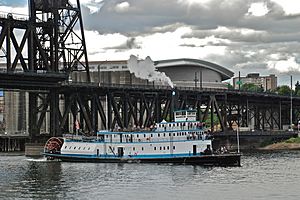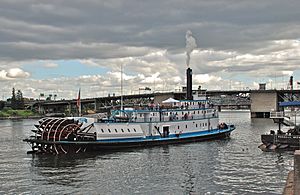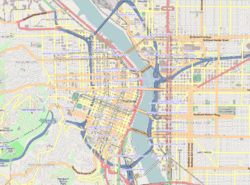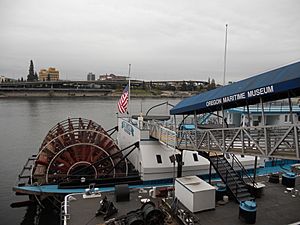Portland (1947 tugboat) facts for kids

Portland passing under the Steel Bridge in 2012
|
|
Quick facts for kids History |
|
|---|---|
| Name | Portland |
| Owner | Oregon Maritime Museum |
| Port of registry | |
| Builder | Northwest Marine Iron Works of Portland, Oregon |
| Cost | $472,000 ($6.19 million in today's dollars) |
| Launched | May 24, 1947 |
| In service | August 29, 1947 |
| Out of service | 1981 |
| Status | Museum ship |
| General characteristics | |
| Type | Shallow draft inland tug |
| Tonnage |
|
| Length | 219 ft (67 m) |
| Beam | 42.1 ft (12.8 m) |
| Draft | 5.5 ft (1.7 m) |
| Installed power | 2 × one-cylinder, 900 hp (670 kW) steam engines |
| Propulsion | 25 ft (7.6 m) diameter, 26 ft (7.9 m) wide stern paddlewheel |
| Crew | two 7-man shifts and 1 cook |
|
Portland (steam tug)
|
|

Portland preparing to dock
|
|
| Location | Portland, Oregon, berthed on the Willamette River at the foot of SW Pine Street |
| Built | 1947 |
| Built by | Northwest Marine Iron Works |
| NRHP reference No. | 97000847 |
| Added to NRHP | August 14, 1997 |
The Portland is a special kind of steamboat called a sternwheel tugboat. It was built in 1947 for the Port of Portland in Oregon, United States.
Today, the Portland is listed on the National Register of Historic Places. It is home to the Oregon Maritime Museum, which owns the boat. You can find the Portland docked along the Willamette River in downtown Portland, near Tom McCall Waterfront Park.
Contents
History of the Portland
The Portland was built in 1947 and started working for the Port of Portland on August 29 of that year. It worked as a tugboat, helping other ships, until it was retired in 1981. By then, the Port of Portland was handling very large oil supertankers from Alaska. These ships were too big for the Portland to help. Also, newer container ships had special bow thrusters that made them easier to move, so they didn't need as much help from tugboats.
When the Portland was being designed, most new boats were using modern diesel engines and propellers. However, the Columbia River Pilots Association asked for the Portland to be built with a traditional steam-powered paddlewheel. Because of this, it became the very last steam-powered, sternwheel tugboat ever built in the United States. It was also the last one still working in the U.S. when it retired in 1981. These reasons are why it's considered so important and is on the National Register of Historic Places.
The Portland was built to replace an older tugboat that had the same name, built in 1919. Unlike the older boat, this Portland has a strong steel hull (the bottom part of the boat) and a wooden superstructure (the parts above the deck).
The Portland as a Museum
In 1991, about ten years after the Portland stopped working, it was given to the Oregon Maritime Museum for just $1. The museum wanted to turn it into a museum ship that would stay in one place. But people were so interested and donated so much money that the museum was able to raise $700,000. This allowed the Portland to be fully fixed up and made able to sail again!
The restoration work was finished in 1993. The ship even took passengers on trips sometimes. However, in 2001, the Coast Guard checked the ship and stopped passenger trips until it could pass a full inspection. The museum then raised another $480,000. Volunteers also put in over a million dollars worth of work over seven years. Finally, in 2008, the ship was cleared to carry passengers again.
In 1994, the Portland moved to its current spot at Tom McCall Waterfront Park in downtown Portland. You can usually visit it for tours most days. In 2002, the museum's exhibits were moved onto the ship, so now they are part of the tour.
Exciting Moments for the Portland
1952 Steamboat Race
On January 24, 1952, the Portland had a fun race against an older sternwheel tugboat called the Henderson. This race was set up to help promote a new movie called Bend of the River, which starred Jimmy Stewart. The movie stars were even riding on the Henderson! The Henderson won the race by about one and a half boat lengths.
1952 Rescue of the S.G. Follis
A large ship named the S.G. Follis was coming into Portland when it got stuck firmly in the sand near the Sauvie Island dike. Other tugboats tried to pull it free, but they couldn't. The Portland attached its lines to the S.G. Follis and then used its powerful paddlewheel to churn the water in reverse. This loosened the sand under the stuck ship, allowing the Portland to pull it free.
1957 Portland Saves a Bridge
On April 14, 1957, two old ships that were going to be taken apart broke free from their ropes. They crashed into the Hawthorne Bridge. Two of the strongest diesel tugboats available tried to help, but they could only slightly reduce the stress on the bridge. The Portland was able to free the ships and tow them to safety before the bridge broke. The Columbia River Pilots Association felt this event proved they were right to insist that the Portland be a steam-powered sternwheeler.
2008 Grounding Incident
In 2008, the Portland was going to be in the first steamboat race on the Columbia River in over 50 years. It was going to re-create the 1952 race against another sternwheeler called the Columbia Gorge. This was part of the Sternwheeler Days Festival in Cascade Locks, Oregon. However, the Portland's steering system got stuck, and it ran into the riverbank, damaging its paddlewheel. Without power or steering, it started to drift towards the Bonneville Dam. Luckily, another tugboat quickly attached a line and towed it to safety. An investigation by the Coast Guard found that the problem was caused by a gear in the steering system that hadn't been fixed properly back in 1997. Since then, the Portland and Columbia Gorge have raced at least three more times, with the Portland winning two of those races.
2012 Collision
As the Portland was docking for the Heritage Maritime Festival in St. Helens, it accidentally backed into a tall ship called the Royaliste. This tall ship belonged to the Portland Pirate Festival. No one was hurt, but the Royaliste was significantly damaged. An investigation into the incident took place.
See also



